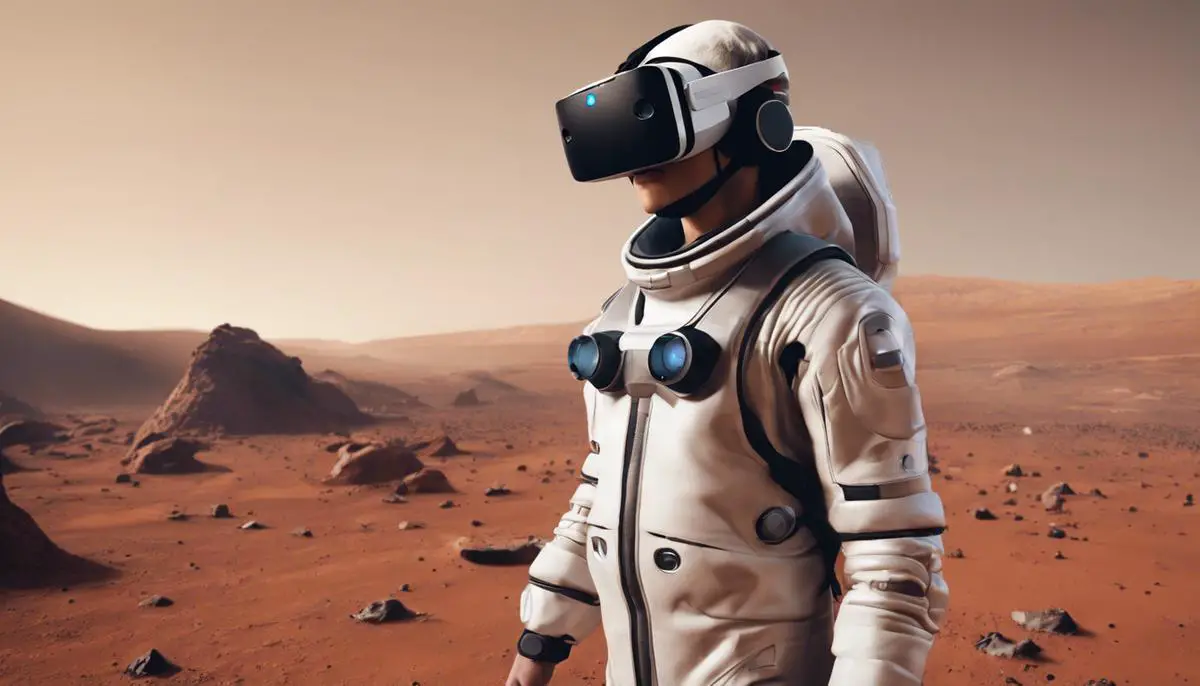Evolution of Mars Exploration
Mars exploration began with telescopes and dreams but quickly moved forward with technology. The journey took a significant leap when NASA's Viking 1 lander touched down on Mars in 1976, giving humanity its first real close-up of the Martian surface. Fast forward to 2012 when the Curiosity rover, a car-sized laboratory on wheels, made its grand entrance onto the Red Planet's dusty terrain. This mission aimed to answer an age-old question: Could Mars have once harbored life?
The data Curiosity sent back was a goldmine. It showed ancient riverbeds and confirmed that Mars once had conditions suitable for life. Despite the leaps in data and understanding, something was missing. The human experience of being on Mars could only be lived vicariously through robotic eyes – until the virtual reality (VR) wave hit.
NASA saw VR as more than gaming gadgets but as a portal to Mars. Teaming up with Google, they converted the Curiosity rover's data into a 3D panorama of Mars you could explore from your living room. With VR headsets like Oculus Rift and HTC Vive, users could stand on Mars, looking at the same rocks and dust that Curiosity did.
In 2016, NASA took it one step further with the "Destination: Mars" exhibit using Microsoft's HoloLens. This mixed-reality experience, led by a hologram of Buzz Aldrin, allowed you to walk around, making the experience closer to stepping on real Martian soil.
VR doesn't stop at museum tours. Professionals at NASA's Jet Propulsion Laboratory use the HoloLens to decide Curiosity's path, turning data analysis into a walk on Mars. This direct engagement with the Martian surface has made mission planning more intuitive.
As VR technology grows more sophisticated, the line between real and virtual continues to blur. Projects like Mars 2030 and Galaxy Explorer aim to simulate the Martian environment down to the last detail, from gravity to geographical features, relying on meticulous modeling and actual NASA data.
VR also presents a practical tool for handling the psychological challenges spacefarers might face. There's research into using virtual realities as a countermeasure against the isolation and monotony of interplanetary travel. Through VR, astronauts could enjoy virtual nature walks on Earth or visit their families back home, making long-duration missions more bearable.
Digital advances have ushered in a new era of exploration where virtual footprints precede physical ones, bridging the divide between humanity and Mars faster than any spacecraft to date. As scientists strive to plant actual boots on Martian ground, VR tools ensure we familiarize ourselves with our second home long before we officially become its neighbors.
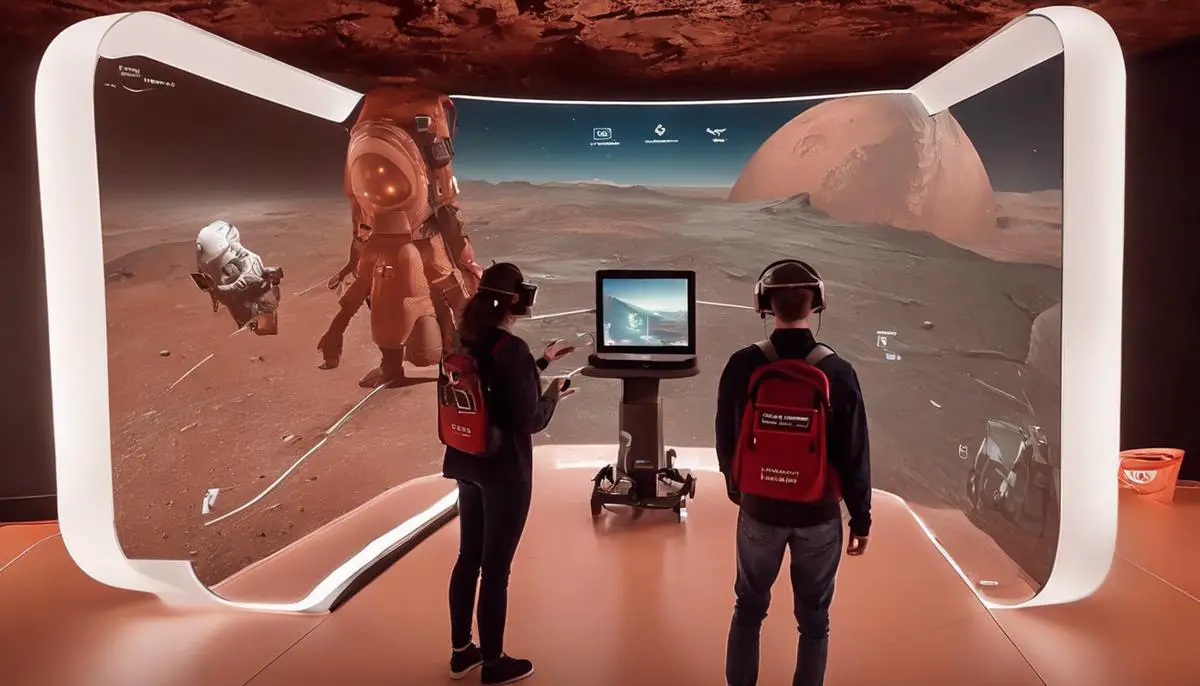
Technological Foundations
The technology orchestrating these virtual sojourns to Mars is both vast and complex. At the center lie VR headsets like the Oculus Rift and HTC Vive. These devices are sophisticated systems that track head movements to provide immersive, 360-degree visual experiences. Their high-definition displays bring the Martian landscape to life with stunning clarity. Advancements in haptic feedback technology mean that users can experience tangible sensations, reinforcing the illusion of a physical presence on Mars.
The software powering these experiences is equally groundbreaking. The Unreal Engine, a powerhouse in game development, is instrumental in creating hyper-realistic simulations of Mars. This engine can render complex landscapes with astonishing detail and accuracy, from the rust-colored dust to the jagged cliffs and mountains. The engine's robust architecture and ability to integrate real-world data into virtual environments make this possible.
This is where NASA and other space agencies play a critical role. Years of Mars exploration missions have yielded a trove of images, data, and insights about the planet's geography, climate, and geological history. By feeding this information into software like the Unreal Engine, developers can reconstruct Mars in virtual reality with unprecedented precision. Satellite imagery maps out the Martian terrain, while rovers and landers contribute detailed surface analyses, enabling the recreation of specific locations on Mars with high fidelity.
One innovative use of such data is seen in NASA's Jet Propulsion Laboratory's "OnSight" project. This software, combined with Microsoft's HoloLens, allows researchers to 'walk' on Mars, offering a 3D perspective on landscapes previously only seen in two dimensions. This shift from abstract images to tangible realities has revolutionized how scientists study Mars.
As groundbreaking as these technologies are, we stand on the brink of further advancements in VR that promise even more realistic explorations of Mars. The ongoing development of virtual reality technology, alongside cutting-edge spatial audio and even scent simulation, means future virtual tours could be more multisensory. With the perpetually improving capability to transmit high-resolution images and data from Mars to Earth, the raw materials for these virtual realms only grow richer.
The collaboration between technological innovation and space exploration has opened up a new frontier not just in how we study other worlds, but in how we experience them. While physically setting foot on Mars remains a future goal, virtual reality has already propelled us into an era where exploration boundaries are defined by our imagination and technological prowess. As we refine and advance these technologies, we draw closer to making life on Mars an experiential reality, preparing ourselves for the day humanity finally makes the leap to becoming interplanetary travelers.
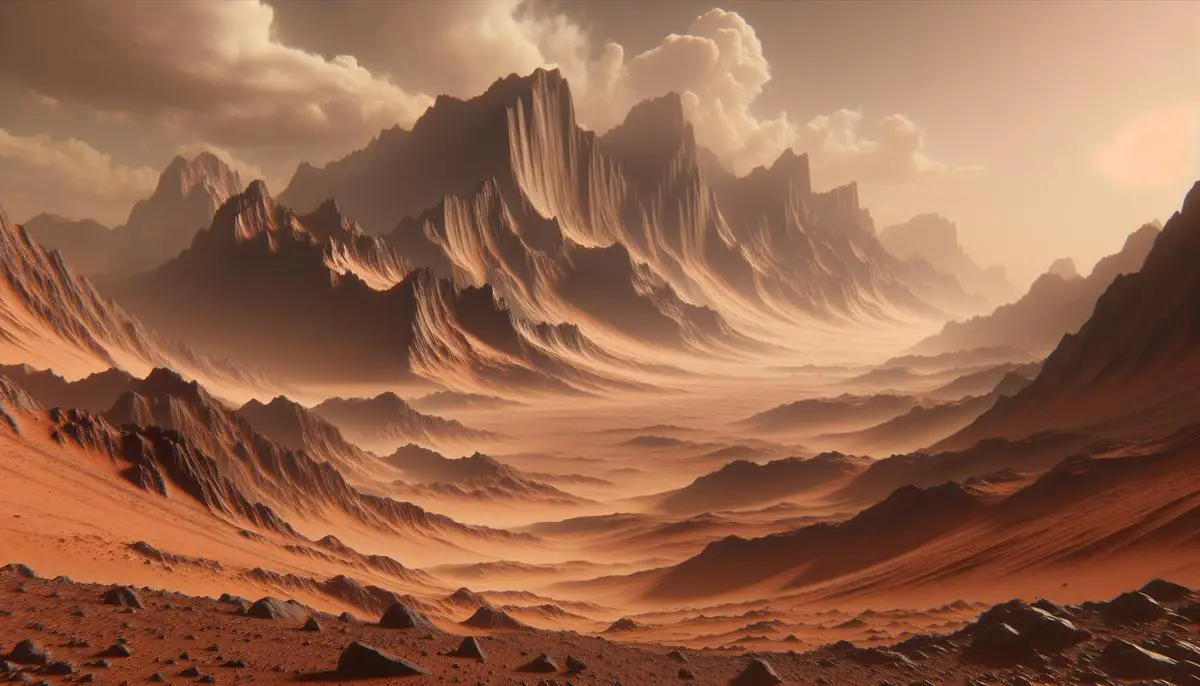
Educational and Training Applications
Immersive technologies, particularly virtual reality, have transformed Mars into a classroom without walls, enabling an unparalleled approach to education and training. For the general public and professionals alike, VR Mars tours have demystified the once remote concept of interplanetary travel, converting it into an experiential learning journey.
The educational benefits of VR Mars tours manifest in various settings, from formal classroom environments to informal public outreach initiatives. For students, these virtual explorations serve as a dynamic textbook, allowing learners to transcend the confines of traditional pedagogy. They provide a platform for interactive learning, where geological formations can be studied up close, and the implications of discoveries such as water ice can be understood in a contextual, hands-on manner. This direct engagement fosters a deeper understanding of Martian science and stimulates interest in STEM fields.
Public outreach campaigns harness the allure of VR to captivate and educate the wider community about Mars exploration missions. Virtual reality tours offer a bridge over the chasm of scientific complexity, making the science of space exploration more accessible. By virtually setting foot on the Red Planet, the public gains a greater appreciation for the challenges and triumphs of space travel.
VR also plays a critical role in the training of astronauts and mission planners. For those preparing for future missions to Mars, virtual reality offers an unprecedented preparatory tool. Astronauts can acquaint themselves with Martian landscapes, practicing navigation and operations in an environment that simulates the Red Planet's unique conditions. This experiential learning extends to emergency scenario preparations, equipment handling, and performing scientific experiments, reducing unpredictability and enhancing mission success prospects.
Within professional circles, VR tours act as a collaborative platform. Scientists and engineers can explore Martian terrains together, conceptualize base builds, and plan rover paths in a shared virtual space despite geographical separations. This collaborative approach optimizes planning efficiencies and fosters a unified vision for future manned missions to Mars.
Virtual reality Mars tours are also finding applications in cross-disciplinary education. Architects envisioning future Martian habitats, environmental scientists studying extraterrestrial weather patterns, and medical professionals preparing for space health challenges all benefit from the experiential learning that VR offers. It provides a common ground for cross-pollination of ideas, essential for the multifaceted preparations required for a successful human presence on Mars.
In harnessing the power of virtual reality for educational and training purposes, humanity is taking significant strides towards turning the dream of Mars exploration into reality. Through immersive VR experiences, we are not only learning about Mars but also about our own capacities to explore, adapt, and thrive in extraplanetary environments. Virtual reality stands as a testament to human ingenuity – a tool that not only educates and trains but inspires the next frontier of discovery.
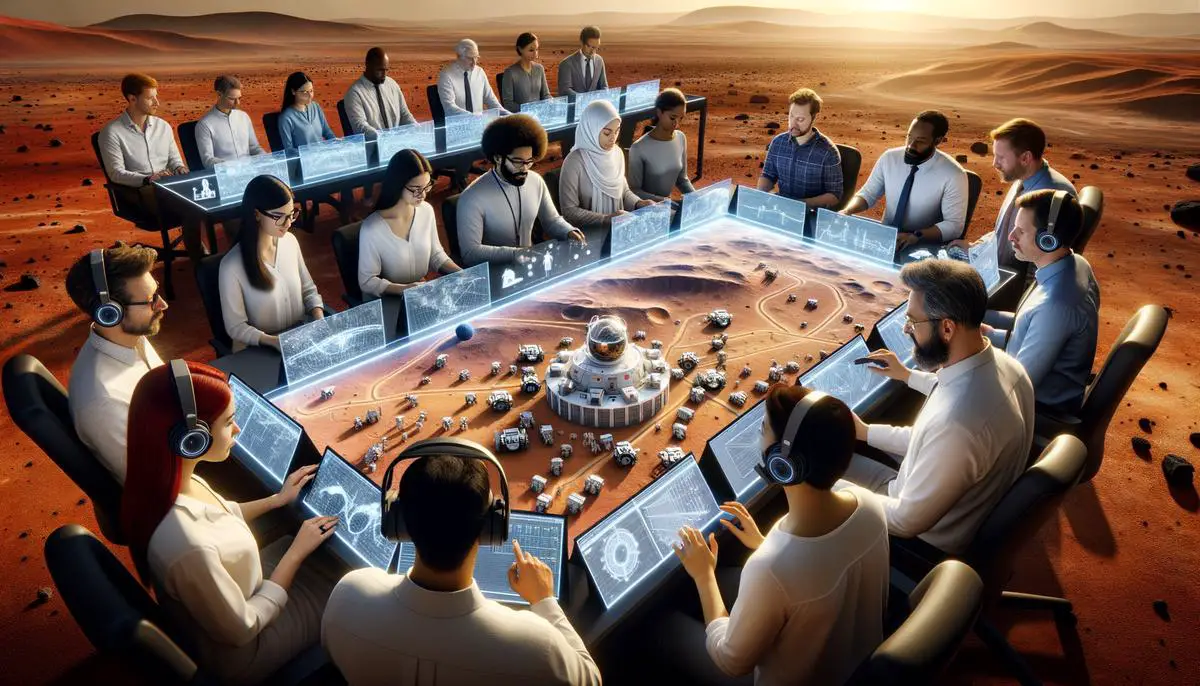
Challenges and Limitations
While the educational and experiential opportunities provided by VR Mars tours paint a picture of a promising future of space exploration, the pathway to this future is not without its hurdles. Technical constraints, financial considerations, and the fidelity of simulated environments each play a pivotal role in shaping the trajectory of VR Mars exploration.
On the technical front, one of the most commonly encountered hindrances is motion sickness — a discord between what the eyes perceive and what the body feels, leading to discomfort for some users. This issue underscores the complexity of creating a genuinely immersive VR experience that can cater to a broad audience without inducing physical discomfort. As engineers and developers strive toward minimizing latency and improving motion tracking within these virtual environments, it remains a significant obstacle to the universal allure of VR Mars tours.
Financing the march toward intricately detailed Martian VR simulations also presents a substantial challenge. High-quality VR technology — encompassing robust processing power, sophisticated headsets, and advanced haptic feedback systems — comes at a high cost. Securing funding to develop and distribute this technology widely enough to make VR Mars tours accessible to a greater portion of the populace requires substantial initial investment and ongoing resources for maintenance and updates.
Additionally, the limitations of current VR platforms in simulating the Martian environment with absolute accuracy must be acknowledged. Despite impressive advancements in digital rendering and data integration, replicating the physical sensations, atmospheric conditions, and precise gravity of Mars remains a daunting task. Users may visually explore realistic terrains modeled on real data from Mars, but the act of walking on its surface, feeling the crunch of Martian dust underfoot, or experiencing the planet's lesser gravity cannot be wholly duplicated with today's technology. These experiential shortcomings highlight a gap between the current capabilities of VR and the long-term goal of offering an experience indistinguishable from setting foot on Mars itself.
Furthermore, this budding industry must navigate the dichotomy between creating genuinely educational content based on scientific data and producing experiences with broader consumer appeal. Striking a balance that captivates the public imagination and remains true to the scientific integrity of Mars exploration efforts is crucial for maintaining both user engagement and educational value.
Despite these challenges, continuous progress in VR technology alongside strategic collaborations between space agencies, educators, and the tech industry signify promising advances towards overcoming these hurdles. While the journey to perfecting VR Mars tours involves navigating technical, financial, and experiential landscapes as complex as the Martian terrain itself, the pursuit ushers in a realm of possibilities for education, training, and public engagement in space exploration. As we confront and surmount these obstacles, we not only move closer to vicarious exploration of Mars but also deepen our collective resolve in making human footprints on Mars a reality.
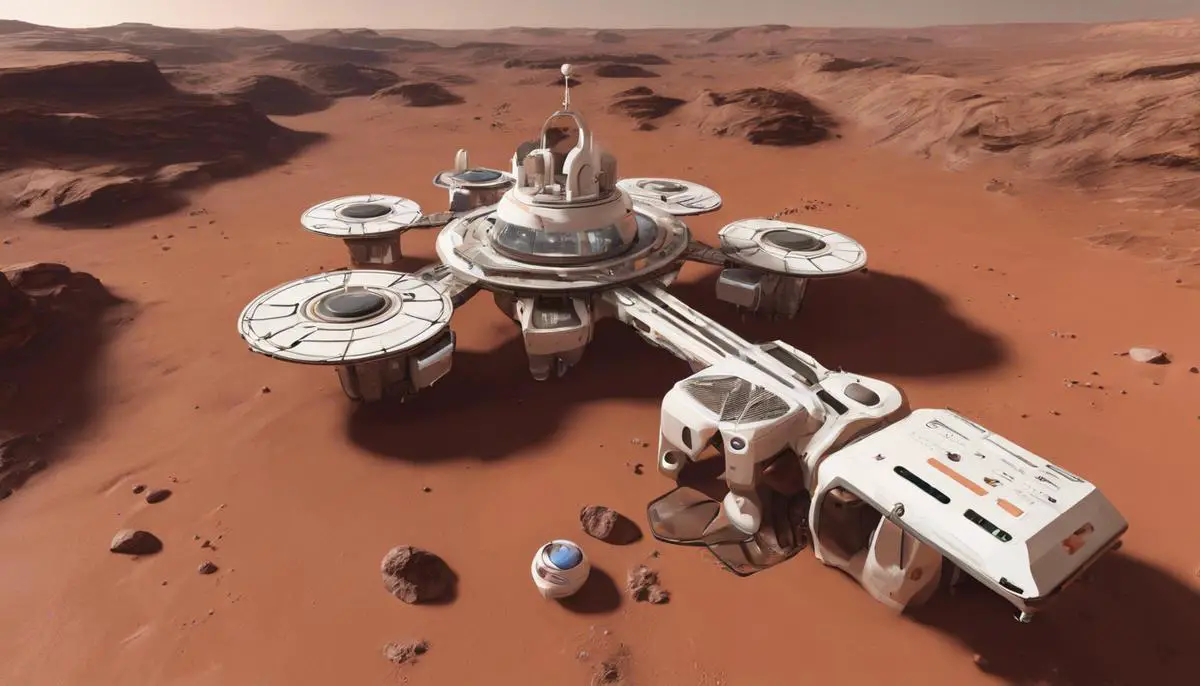
Future Prospects
As we look to the future of VR Mars tours, the panorama of possibilities broadens with each passing moment. The journey toward heightened realism in virtual explorations anticipates advancements that promise to elevate the sensory experience, bringing it ever closer to the tangibility of a first-person narrative on Mars. Future iterations of these technologies could harness the power of artificial intelligence and machine learning, not only to enhance visual fidelity but also to simulate dynamic environmental conditions, adapting in real time to the exploratory whims of the user. As virtual reality becomes increasingly indistinguishable from physical presence, users might feel the Martian wind against their faces, sift finely granulated regolith through their fingers, and hear the haunting silence of an alien world with startling clarity.
The touchstone of future VR Mars exploration lies in its interactivity. Tomorrow's virtual astronauts might not just be passive observers but active participants in a living, breathing Martian ecology. Through advancements in VR hardware and software, users could conduct experiments, drive rovers in real-time, and build habitats, contributing to a shared simulacrum of Mars colonization efforts. This amalgamation of gaming principles with scientific exploration could foster a sandbox of innovation, coalesced around an engaged community of users, researchers, and enthusiasts.
Access to these breathtaking experiences is forecasted to extend beyond the echelons of space aficionados or the academically privileged. The democratization of VR technology could catalyze the proliferation of Mars tours into schools, public institutions, and homes across the world, bridging the interstellar divide. Subsidized VR platforms, mobile compatibility, and open-source software initiatives might soon ensure that a journey to Mars is as accessible as a trip to the local museum or library. This universal doorway to the Red Planet could engender an unprecedented era of public engagement with space exploration, morphing passive interest into active participation and advocacy.
In tandem with these technological tessellations, it's conceivable that the trajectory of these advancements will empower a new pedagogical paradigm. As future educators thread the vast expanse of the solar system from the comfort of a classroom, field trips to Mars could become a staple of interdisciplinary learning, engaging students in a visceral experience of historical exploration, geological analysis, and environmental stewardship on a planetary scale. Such immersive teaching approaches might not only augment comprehension and retention but could also cultivate a generational constellation of scientists, engineers, and explorers intrinsically motivated by their youthful voyages across virtual Martian landscapes.
Moreover, the intertwining strands of VR technology and Mars exploration portend a fascinating symbiosis between humanity's extraterrestrial aspirations and its technological prowess. As missions to Mars inch closer to reality, VR could serve as both a training ground for astronauts and a test bed for terraforming strategies
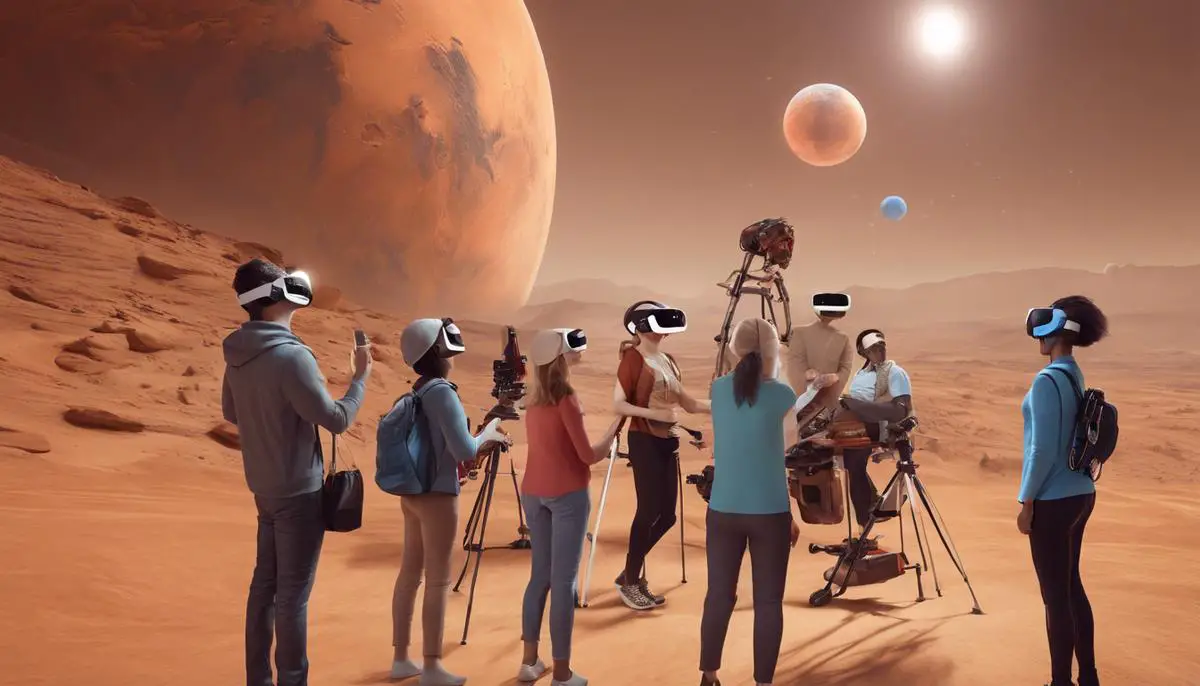
![]()
